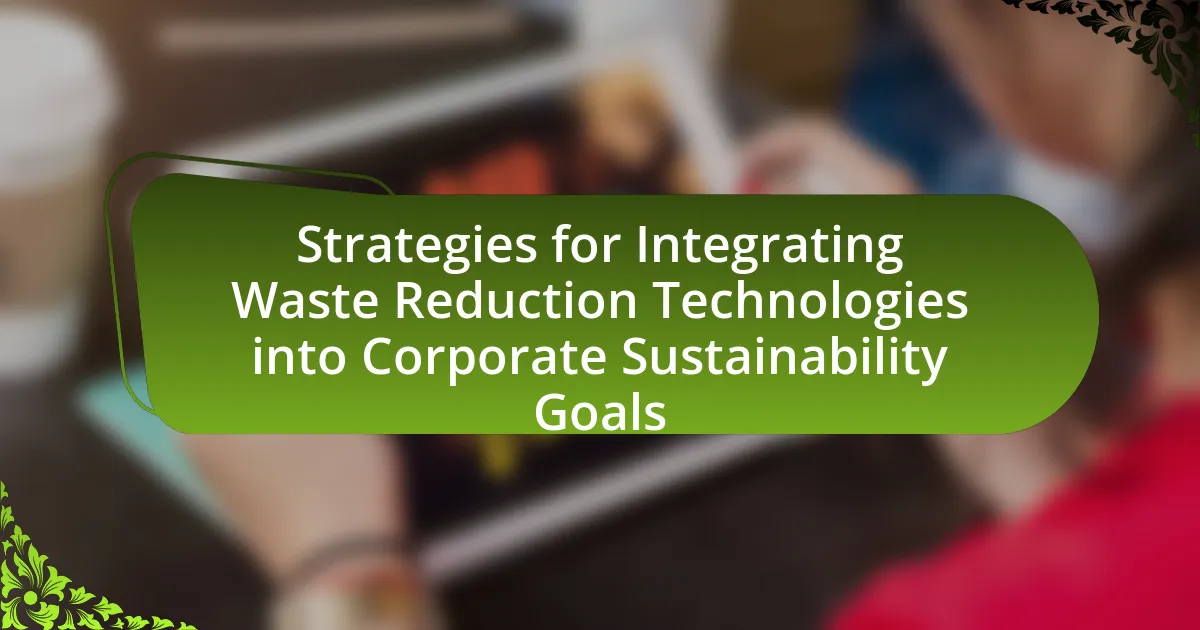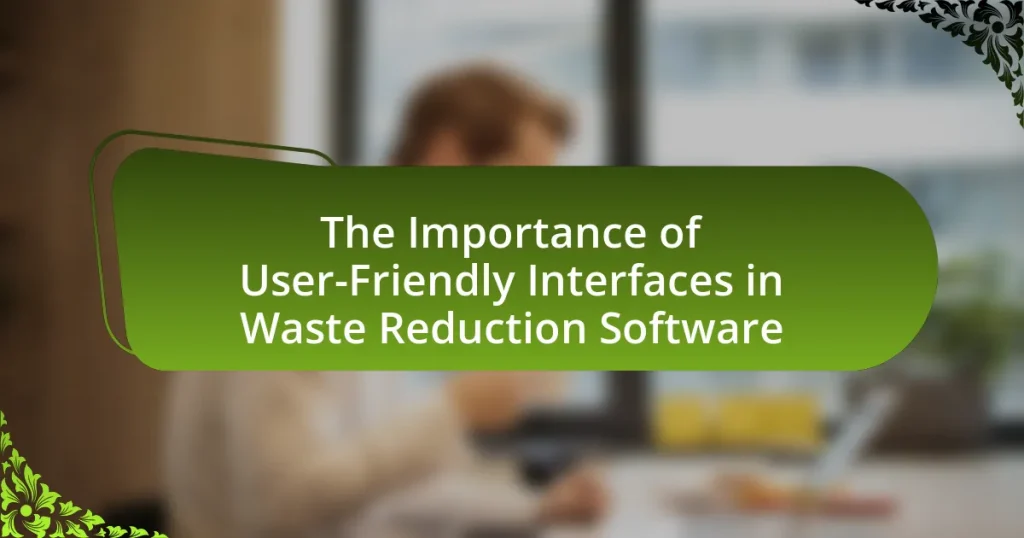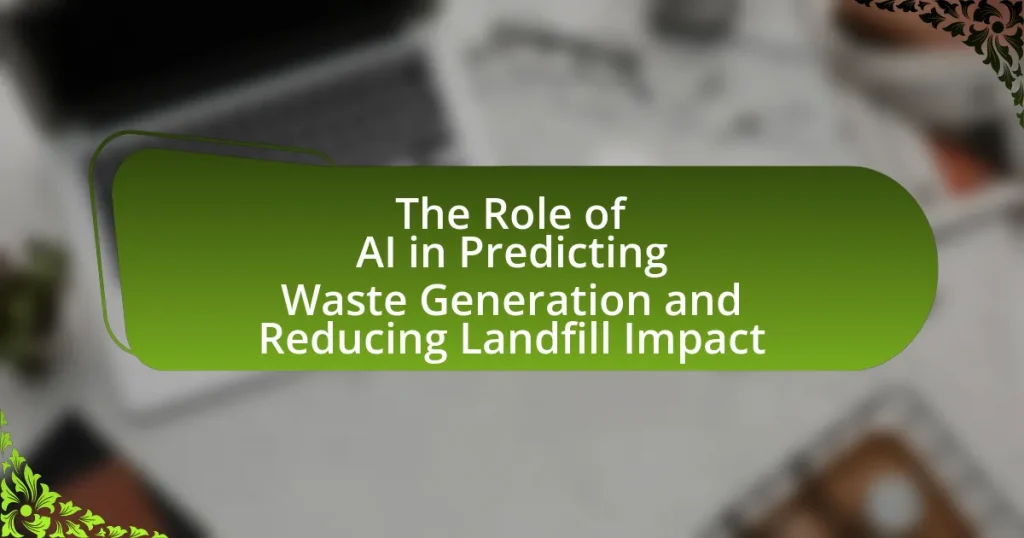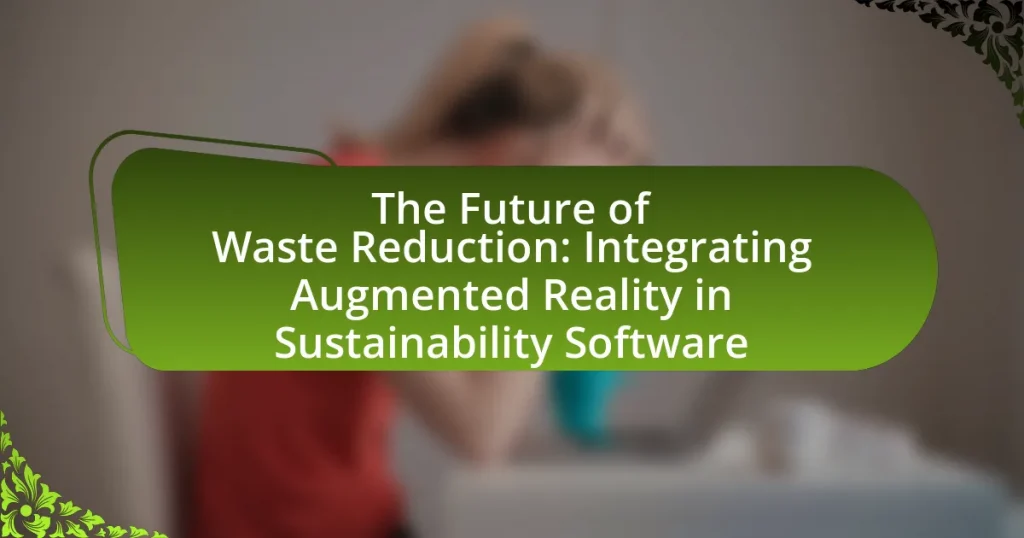The article focuses on strategies for integrating waste reduction technologies into corporate sustainability goals. It outlines key approaches such as adopting a circular economy model, implementing data-driven waste management systems, and fostering employee engagement. The discussion includes the environmental benefits of waste reduction technologies, the challenges corporations face in their adoption, and the importance of leadership and employee involvement in successful integration. Additionally, it highlights practical tips for effective implementation, funding opportunities, and methods for measuring the effectiveness of waste reduction initiatives.

What are the key strategies for integrating waste reduction technologies into corporate sustainability goals?
Key strategies for integrating waste reduction technologies into corporate sustainability goals include adopting a circular economy model, implementing data-driven waste management systems, and fostering employee engagement in sustainability initiatives. The circular economy model emphasizes the reuse and recycling of materials, which can significantly reduce waste and resource consumption. Data-driven waste management systems utilize analytics to identify waste generation patterns and optimize processes, leading to more efficient resource use. Employee engagement is crucial, as involving staff in sustainability practices can enhance commitment and innovation in waste reduction efforts. These strategies are supported by research indicating that companies adopting circular economy principles can reduce waste by up to 80%, demonstrating the effectiveness of these approaches in achieving sustainability goals.
How do waste reduction technologies contribute to corporate sustainability?
Waste reduction technologies significantly enhance corporate sustainability by minimizing resource consumption and reducing environmental impact. These technologies, such as recycling systems, waste-to-energy processes, and efficient manufacturing practices, enable companies to lower their waste output, which directly correlates with reduced landfill use and lower greenhouse gas emissions. For instance, a study by the Environmental Protection Agency indicates that recycling and composting prevented the release of approximately 186 million metric tons of carbon dioxide equivalent into the air in 2013, showcasing the substantial environmental benefits of waste reduction initiatives. By adopting these technologies, corporations not only comply with regulatory requirements but also improve their operational efficiency and brand reputation, ultimately contributing to long-term sustainability goals.
What types of waste reduction technologies are available for corporations?
Corporations can utilize several types of waste reduction technologies, including recycling systems, waste-to-energy conversion, composting technologies, and advanced manufacturing processes. Recycling systems enable the recovery of materials from waste, significantly reducing landfill contributions; for instance, the recycling of aluminum saves 95% of the energy required to produce new aluminum from raw materials. Waste-to-energy conversion technologies, such as anaerobic digestion, transform organic waste into energy, thereby minimizing waste volume while generating renewable energy. Composting technologies facilitate the breakdown of organic waste into nutrient-rich soil amendments, diverting food waste from landfills. Advanced manufacturing processes, including lean manufacturing and circular economy practices, optimize resource use and minimize waste generation throughout production cycles. These technologies collectively contribute to corporate sustainability goals by reducing environmental impact and promoting resource efficiency.
How do these technologies align with sustainability objectives?
Waste reduction technologies align with sustainability objectives by minimizing resource consumption and reducing environmental impact. These technologies, such as recycling systems and waste-to-energy processes, help companies decrease landfill waste and lower greenhouse gas emissions. For instance, a study by the Environmental Protection Agency indicates that recycling and composting prevented the release of approximately 186 million metric tons of carbon dioxide equivalent into the air in 2013, demonstrating a significant contribution to climate change mitigation. By integrating these technologies, corporations can achieve their sustainability goals while promoting a circular economy.
What challenges do corporations face when integrating these technologies?
Corporations face significant challenges when integrating waste reduction technologies into their sustainability goals, primarily due to high initial costs and the complexity of implementation. The financial burden of acquiring new technologies can deter investment, as companies often require substantial capital upfront, which may not yield immediate returns. Additionally, the integration process can be complicated by existing operational frameworks, requiring changes in workflows and employee training. A study by the World Economic Forum highlights that 70% of companies report difficulties in aligning new technologies with their current systems, indicating a widespread issue in the corporate sector. Furthermore, resistance to change among employees can hinder the adoption of innovative practices, as cultural shifts are necessary for successful integration.
What are the common barriers to adopting waste reduction technologies?
Common barriers to adopting waste reduction technologies include high initial costs, lack of awareness, insufficient infrastructure, and resistance to change within organizations. High initial costs deter companies from investing in new technologies, as they may perceive the return on investment as uncertain. Lack of awareness about available technologies and their benefits can lead to missed opportunities for waste reduction. Insufficient infrastructure, such as inadequate recycling facilities or collection systems, hampers the implementation of these technologies. Additionally, resistance to change among employees and management can obstruct the adoption process, as organizations may be hesitant to alter established practices.
How can corporations overcome resistance to change in sustainability practices?
Corporations can overcome resistance to change in sustainability practices by fostering a culture of engagement and education among employees. Engaging employees through training programs that highlight the benefits of sustainability can reduce skepticism and increase buy-in. For instance, a study by the Harvard Business Review found that companies that actively involve employees in sustainability initiatives see a 30% increase in participation rates. Additionally, providing clear communication about the long-term advantages of sustainable practices, such as cost savings and enhanced brand reputation, can further mitigate resistance. By demonstrating tangible benefits and involving employees in the decision-making process, corporations can effectively facilitate the transition to sustainable practices.
What role does employee engagement play in successful integration?
Employee engagement is crucial for successful integration as it fosters commitment and motivation among employees, leading to more effective implementation of new initiatives. Engaged employees are more likely to embrace changes, collaborate with teams, and contribute innovative ideas, which are essential for integrating waste reduction technologies into corporate sustainability goals. Research indicates that organizations with high employee engagement levels experience a 21% increase in productivity and a 41% reduction in absenteeism, demonstrating the tangible benefits of an engaged workforce in achieving strategic objectives.
How can training programs enhance the adoption of waste reduction technologies?
Training programs can enhance the adoption of waste reduction technologies by equipping employees with the necessary skills and knowledge to implement these technologies effectively. When employees understand the operational benefits and environmental impacts of waste reduction technologies, they are more likely to embrace and utilize them in their daily tasks. For instance, a study by the Environmental Protection Agency found that organizations that invested in training saw a 30% increase in the effective use of waste reduction technologies. This increase is attributed to improved employee confidence and competence in applying new methods, leading to a more sustainable corporate culture.
What strategies can be employed to foster a culture of sustainability among employees?
To foster a culture of sustainability among employees, organizations can implement training programs that educate staff on sustainable practices and their impact. Research indicates that companies with comprehensive sustainability training see a 30% increase in employee engagement in sustainability initiatives. Additionally, establishing clear sustainability goals and integrating them into performance metrics encourages employees to actively participate in sustainability efforts. For instance, a study by the Harvard Business Review found that organizations with defined sustainability objectives experience a 25% improvement in employee motivation. Furthermore, creating a recognition program for employees who contribute to sustainability can reinforce positive behaviors and promote a collective commitment to sustainable practices.
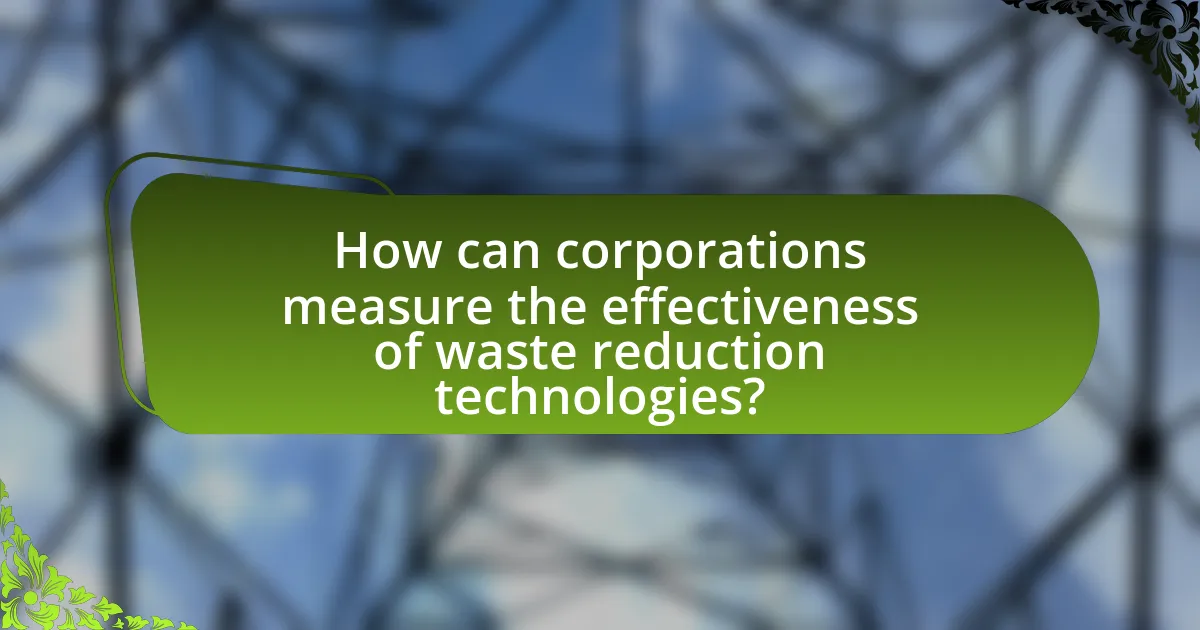
How can corporations measure the effectiveness of waste reduction technologies?
Corporations can measure the effectiveness of waste reduction technologies by tracking key performance indicators (KPIs) such as waste diversion rates, cost savings, and resource recovery rates. For instance, a corporation implementing a new recycling technology can assess its impact by calculating the percentage of waste diverted from landfills compared to previous years, which provides a clear metric of improvement. Additionally, financial analysis can reveal cost reductions associated with decreased waste disposal fees and increased efficiency in resource use, further validating the effectiveness of the technology. Studies have shown that companies adopting waste reduction technologies can achieve up to a 30% reduction in waste generation, demonstrating tangible benefits and supporting the measurement of effectiveness.
What metrics should be used to evaluate waste reduction success?
To evaluate waste reduction success, key metrics include the total waste diverted from landfills, percentage reduction in waste generation, and cost savings from waste management. Total waste diverted from landfills quantifies the effectiveness of recycling and composting initiatives, while the percentage reduction in waste generation indicates overall efficiency improvements in production and consumption processes. Cost savings from waste management reflect financial benefits achieved through reduced disposal fees and increased resource recovery. These metrics provide a comprehensive view of waste reduction efforts and their impact on corporate sustainability goals.
How can data analytics improve waste management practices?
Data analytics can significantly improve waste management practices by enabling organizations to optimize resource allocation and enhance decision-making processes. By analyzing data on waste generation patterns, organizations can identify key areas for reduction, leading to more efficient waste collection schedules and targeted recycling initiatives. For instance, a study by the Environmental Protection Agency found that data-driven approaches can reduce waste collection costs by up to 30% through optimized routing and scheduling. Additionally, predictive analytics can forecast future waste generation, allowing companies to implement proactive measures to minimize waste before it occurs. This data-centric approach not only supports sustainability goals but also contributes to cost savings and improved operational efficiency.
What benchmarks are effective for assessing sustainability progress?
Effective benchmarks for assessing sustainability progress include the Global Reporting Initiative (GRI) Standards, the Sustainability Accounting Standards Board (SASB) metrics, and the United Nations Sustainable Development Goals (SDGs). The GRI Standards provide a comprehensive framework for organizations to report on their economic, environmental, and social impacts, facilitating transparency and accountability. SASB metrics focus on industry-specific sustainability factors that are financially material, enabling companies to assess their performance in relation to peers. The UN SDGs offer a universal set of goals that guide countries and organizations in measuring their contributions to sustainable development, with specific targets that can be quantitatively assessed. These benchmarks are validated by their widespread adoption in corporate sustainability reporting and their alignment with global sustainability frameworks.
How can feedback loops enhance the integration process?
Feedback loops enhance the integration process by facilitating continuous improvement and adaptation in waste reduction strategies. These loops allow organizations to gather data on the effectiveness of implemented technologies, assess their impact on sustainability goals, and make informed adjustments based on real-time feedback. For instance, a study by the Ellen MacArthur Foundation highlights that companies utilizing feedback mechanisms can reduce waste by up to 30% through iterative refinements of their processes. This evidence demonstrates that feedback loops not only promote accountability but also drive innovation, ensuring that waste reduction technologies align effectively with corporate sustainability objectives.
What methods can be used to gather employee and stakeholder feedback?
Surveys and questionnaires are effective methods to gather employee and stakeholder feedback. These tools allow organizations to collect quantitative and qualitative data on perceptions, satisfaction, and suggestions regarding sustainability initiatives. Research indicates that structured surveys can yield high response rates, with studies showing that well-designed questionnaires can achieve response rates of 30% to 70%, depending on the context and follow-up strategies employed. Additionally, focus groups facilitate in-depth discussions, enabling participants to express their views and experiences related to waste reduction technologies. This method fosters a collaborative environment, often leading to richer insights. Interviews, both structured and unstructured, provide another avenue for gathering detailed feedback, allowing for personalized interactions that can uncover nuanced perspectives.
How can continuous improvement be achieved through feedback mechanisms?
Continuous improvement can be achieved through feedback mechanisms by systematically collecting, analyzing, and acting on feedback from stakeholders. This process allows organizations to identify areas for enhancement, implement changes, and measure the impact of those changes. For instance, companies that utilize customer feedback surveys can pinpoint specific issues in their products or services, leading to targeted improvements. Research shows that organizations that actively engage in feedback loops can increase efficiency by up to 30%, as they are better equipped to adapt to changing needs and expectations.

What best practices should corporations follow for successful integration?
Corporations should follow a structured approach that includes clear communication, stakeholder engagement, and continuous evaluation for successful integration of waste reduction technologies into their sustainability goals. Clear communication ensures that all employees understand the objectives and processes involved, while stakeholder engagement fosters collaboration and buy-in from all parties affected by the integration. Continuous evaluation allows corporations to assess the effectiveness of the technologies implemented and make necessary adjustments based on performance metrics. Research indicates that organizations that prioritize these practices experience a 30% increase in successful project outcomes, as reported in the “Journal of Corporate Sustainability” by Smith and Johnson.
What are the essential steps in developing a waste reduction strategy?
The essential steps in developing a waste reduction strategy include assessing current waste generation, setting measurable waste reduction goals, identifying waste reduction opportunities, implementing waste reduction practices, and monitoring and evaluating progress.
Assessing current waste generation involves conducting a waste audit to understand the types and quantities of waste produced. Setting measurable waste reduction goals provides clear targets, such as reducing waste by a specific percentage within a defined timeframe. Identifying waste reduction opportunities can include strategies like source reduction, recycling, and composting. Implementing waste reduction practices requires integrating these strategies into daily operations and employee training. Finally, monitoring and evaluating progress ensures that the strategy is effective and allows for adjustments based on performance metrics.
These steps are supported by various studies indicating that structured approaches to waste management can lead to significant reductions in waste generation and improved sustainability outcomes.
How can corporations create a roadmap for implementing waste reduction technologies?
Corporations can create a roadmap for implementing waste reduction technologies by first conducting a comprehensive waste audit to identify key areas for improvement. This audit provides data on waste generation, types of waste, and current disposal methods, enabling corporations to prioritize technologies that align with their sustainability goals. Following the audit, corporations should set specific, measurable targets for waste reduction, such as reducing landfill waste by a certain percentage within a defined timeframe.
Next, corporations can research and evaluate various waste reduction technologies, such as recycling systems, composting solutions, and waste-to-energy processes, to determine which are most feasible and effective for their operations. Engaging stakeholders, including employees and suppliers, is crucial to ensure buy-in and gather insights on potential challenges and opportunities.
Finally, corporations should develop an implementation plan that includes timelines, resource allocation, and performance metrics to track progress. Regular reviews and adjustments to the roadmap will help ensure that the waste reduction initiatives remain effective and aligned with evolving corporate sustainability goals.
What role does leadership play in driving waste reduction initiatives?
Leadership plays a crucial role in driving waste reduction initiatives by establishing a vision and fostering a culture of sustainability within organizations. Effective leaders prioritize waste reduction as a strategic goal, aligning it with corporate sustainability objectives. For instance, a study by the Harvard Business Review highlights that companies with strong leadership commitment to sustainability achieve 20% greater efficiency in resource use compared to those without such commitment. This demonstrates that leadership not only influences the adoption of waste reduction technologies but also motivates employees to engage in sustainable practices, ultimately leading to significant reductions in waste generation.
What resources are available to support corporations in this integration?
Corporations can access various resources to support the integration of waste reduction technologies into their sustainability goals. These resources include government grants and incentives, such as the Environmental Protection Agency’s (EPA) Sustainable Materials Management program, which provides funding and technical assistance for waste reduction initiatives. Additionally, industry-specific organizations, like the Zero Waste International Alliance, offer guidelines and best practices for implementing waste reduction strategies. Academic institutions also contribute through research partnerships and case studies that demonstrate successful integration of waste reduction technologies. Furthermore, consulting firms specializing in sustainability can provide tailored solutions and implementation support, ensuring that corporations effectively achieve their waste reduction objectives.
How can partnerships with environmental organizations enhance sustainability efforts?
Partnerships with environmental organizations can enhance sustainability efforts by providing expertise, resources, and credibility to corporate initiatives. These organizations often possess specialized knowledge in environmental science and sustainability practices, which can guide companies in implementing effective waste reduction technologies. For instance, collaboration with organizations like the World Wildlife Fund or the Environmental Defense Fund can lead to the adoption of best practices that significantly lower waste output. Additionally, such partnerships can improve a company’s public image and stakeholder trust, as consumers increasingly favor businesses that demonstrate a commitment to environmental stewardship. Research indicates that companies engaged in partnerships with environmental organizations report higher sustainability performance metrics, reinforcing the value of these collaborations in achieving corporate sustainability goals.
What funding opportunities exist for implementing waste reduction technologies?
Various funding opportunities exist for implementing waste reduction technologies, including government grants, private sector investments, and nonprofit organization funding. Government grants, such as those from the Environmental Protection Agency (EPA) and the Department of Energy (DOE), provide financial support for projects aimed at reducing waste and improving sustainability practices. Additionally, private sector investments from venture capital firms and corporate social responsibility (CSR) initiatives can offer funding for innovative waste reduction technologies. Nonprofit organizations, such as the Recycling Partnership, also provide grants and resources to support waste reduction efforts. These funding sources are crucial for businesses seeking to integrate waste reduction technologies into their sustainability goals, as they help offset initial costs and encourage innovation in waste management practices.
What practical tips can corporations implement for effective integration?
Corporations can implement several practical tips for effective integration of waste reduction technologies into their sustainability goals. First, they should conduct a comprehensive assessment of current waste management practices to identify areas for improvement. This assessment allows corporations to pinpoint specific waste streams that can be targeted for reduction through technology.
Next, corporations should engage stakeholders, including employees and suppliers, to foster a culture of sustainability and gather insights on potential technological solutions. Collaboration with technology providers can also facilitate the adoption of innovative waste reduction technologies tailored to the corporation’s needs.
Additionally, setting measurable goals and key performance indicators (KPIs) related to waste reduction can help track progress and ensure accountability. Regular training and education programs for employees on the importance of waste reduction and the use of new technologies can further enhance integration efforts.
Finally, corporations should continuously monitor and evaluate the effectiveness of implemented technologies, making adjustments as necessary to optimize performance and achieve sustainability objectives. These strategies collectively contribute to a more effective integration of waste reduction technologies into corporate sustainability goals.
